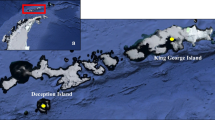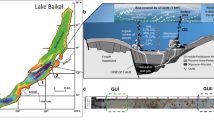Abstract
A microbial enrichment culture tolerant of petroleum hydrocarbons was developed from sediment collected near Casey Station, Antarctica. To select cold-adapted microbes that would degrade diesel, enrichments were cultured at 0°C during six successive transfers to fresh medium, with Special Antarctic Blend diesel (SAB) as the sole carbon source. Biodegradation of components of the SAB was then measured in microcosms inoculated with the enrichment culture. After 16 weeks, the amount of biodegradation was small, but nonane (a C9 alkane) had degraded significantly more in inoculated microcosms than in sterile controls. DNA was then extracted from the enrichment cultures and a fragment of the 16S rRNA gene was amplified for denaturing gradient gel electrophoresis. Bands were excised from the gel and, following sequencing, were found to belong to the genera Pseudomonas and Colwellia.


Similar content being viewed by others
References
Beilen JB van, Smits THM, Whyte LG, Schorcht S, Rothlisberger M, Plaggemeier T, Engesser KH, Witholt B (2002) Alkane hydroxylase homologues in gram-positive strains. Environ Microbiol 4:676–682
Bowman JP, McCammon SA, Gibson JAE, Robertson L, Nichols PD (2003) Prokaryotic metabolic activity and community structure in Antarctic continental shelf sediments. Appl Environ Microbiol 69:2448–2462
Brinkmeyer R, Knittel K, Jurgens J, Weyland H, Amann R, Helmke E (2003) Diversity and structure of bacterial communities in Arctic versus Antarctic pack ice. Appl Environ Microbiol 69:6610–6619
Delille D, Pelletier E (2002) Natural attenuation of diesel-oil contamination in a subantarctic soil (Crozt Island). Polar Biol 25:628–687
Delille D, Basseres A, Dessommes A (1997) Seasonal variation of bacteria in sea ice contaminated by diesel fuel and dispersed crude oil. Microb Ecol 33:97–105
Grice K, Alexander R, Kagi RI (2000) Diamondoid hydrocarbon ratios as indicators of biodegradation in Australian crude oils. Org Geochem 31:67–73
Kerry E (1993) Bioremediation of experimental petroleum spills on mineral soils in the Vestfold Hills, Antarctica. Polar Biol 13:163–170
Mergaert J, Verhelst A, Cnockaert MC, Tan TL, Swings J (2001) Characterisation of facultative oligotrophic bacteria from polar seas by analysis of their fatty acids and 16S rDNA sequences. Syst Appl Microbiol 24:98–107
Powell SM, Bowman JP, Snape I, Stark JS (2003) Microbial community variation in pristine and polluted nearshore Antarctic sediments. FEMS Microbiol Ecol 45:135–145
Rabus R, Nordhaus R, Ludwig W, Widdel F (1993) Complete oxidation of toluene under strictly anoxic conditions by a new sulfate-reducing bacterium. Appl Environ Microbiol 59:1444–1451
Robson JN, Rowland SJ (1987) Biodegradation of highly branched isoprenoid hydrocarbons: a possible explanation of sedimentary abundance. Adv Org Geochem 13:691–695
Sei K, Sugimoto Y, Mori K, Maki H, Kohno T (2003) Monitoring of alkane-degrading bacteria in a sea-water microcosm during crude oil degradation by polymerase chain reaction based on alkane-catabolic genes. Environ Microbiol 5:517–522
Smets BF, Pritchard PH (2003) Elucidating the microbial component of natural attenuation. Curr Opin Biotechnol 14:283–288
Stark JS, Riddle MJ, Snape I, Scouller RC (2003) Human impacts in Antarctic marine soft-sediment assemblages: correlations between multivariate biological patterns and environmental variables. Estuarine Coastal Shelf Sci 56:717–734
Vomberg A, Klinner U (2000) Distribution of alkB genes within n-alkane degrading bacteria. J Appl Microbiol 89:339–348
Watkinson RJ, Morgan P (1990) Physiology of aliphatic hydrocarbon-degrading microorganisms. Biodegradation 1:79–92
Yakimov MM, Golyshin PN, Lang S, Moore ER, Abraham WR, Lunsdorf H, Timmis KN (1998) Alcanivorax borkumensis gen. nov., sp. nov., a new, hydrocarbon-degrading and surfactant-producing marine bacterium. Int J Syst Bacteriol 48:339–348
Yakimov MM, Giuliano L, Bruni V, Scarfi S, Golyshin PN (1999) Characterisation of Antarctic hydrocarbon degrading bacteria capable of producing bioemulsifiers. Microbiologica 22:249–256
Yakimov MM, Giuliano L, Gentile G, Crisafi E, Chernikova TN, Abraham WR, Lunsdorf H, Timmis KN, Golyshin PN (2003) Oleispira antarctica gen. nov., sp. nov., a novel hydrocarbonoclastic marine bacterium isolated from Antarctic coastal sea water. Int J Syst Evol Microbiol 53:779–785
Acknowledgements
The authors would like to thank Susan Ferguson (Australian Antarctic Division) for assistance in setting up and running the microcosm experiments, and Paul Harvey (Australian Antarctic Division) for carrying out the hydrocarbon analyses.
Author information
Authors and Affiliations
Corresponding author
Rights and permissions
About this article
Cite this article
Powell, S.M., Bowman, J.P. & Snape, I. Degradation of nonane by bacteria from Antarctic marine sediment. Polar Biol 27, 573–578 (2004). https://doi.org/10.1007/s00300-004-0639-8
Received:
Revised:
Accepted:
Published:
Issue Date:
DOI: https://doi.org/10.1007/s00300-004-0639-8




